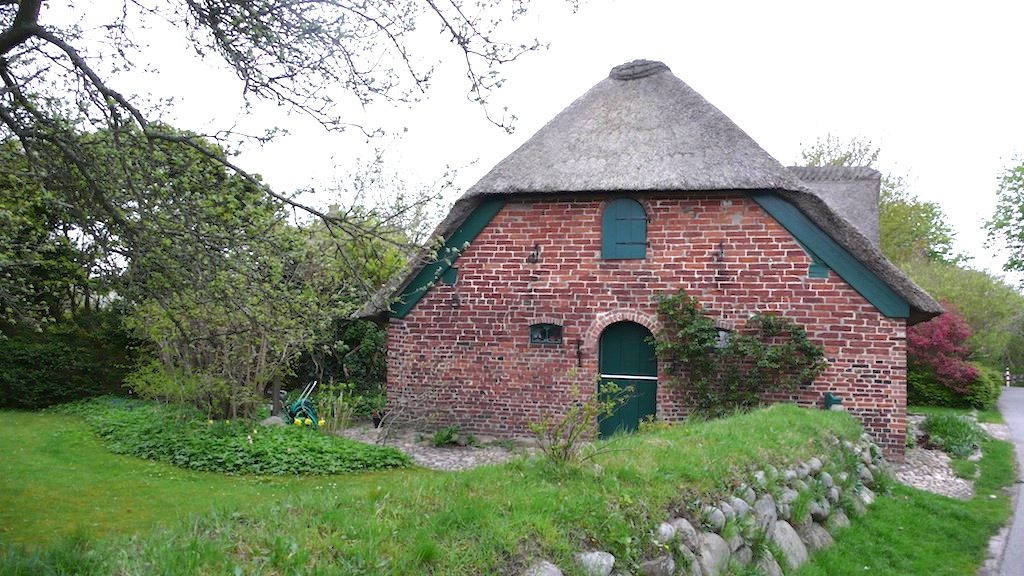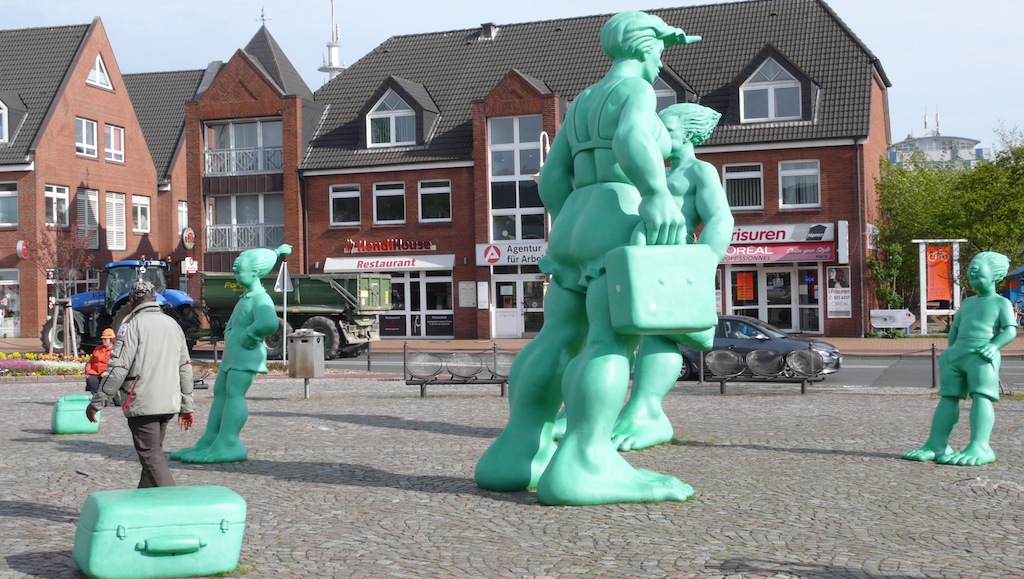If you are one of those gay men haunted by the image of the nubile Tadzio in silhouette at the water’s edge in Luchino Visconti’s masterful cinematic vision of Thomas Mann’s homoerotic novella, Death in Venice, then you must travel to the enchanted isle of Sylt.
Here, on Germany’s northernmost island, a windswept landscape of majestic cliffs and lush meadows and flowering heathland and unspoiled sand dunes that range in age from 3,000-8,000 years old, here at the edge of the red sand cliffs is where you will find Haus Kliffende where Mann lived and wrote and witnessed the pulchritude of German youth as they frolicked on the wide beaches of Germany’s most famous holiday isle.
For over a century, Sylt has been a sanctuary for writers, journalists, publishers, and performing artists, thereby insuring that the island’s fabled beauty is immortalized in art. Those who have been smitten by Provincetown on Cape Cod will recognize immediately the similarities: a literary haven at land’s end, supported by a live-and-let-live culture comprised of fishermen and naturists and naturalists.
While Sylt has been a fashionable seaside resort since the 19th century, the island has become in recent years a summer destination for German celebrities and a global jetsetting population, many of whom maintain secondary and tertiary residences in Kampen and other villages (and are sometimes referred to by the locals as “schicki Mickis”). Alongside this influx has been an invasion of upscale boutiques, so that many of the island’s ubiquitous thatched roof houses are now home to luxury purveyors such as Hermès, Cartier, Bulgari, and Louis Vuitton. The island also has no less than six Michelin-starred restaurants – and three of them with two stars.
Located as far north as the southernmost tip of Alaska, Sylt was severed from the mainland about 8,000 years ago – and it wasn’t until 1927 that the narrow barrier island was reconnected to the rest of Germany by a nearly seven-mile-long causeway. Prior to the causeway’s construction, visitors to Sylt were at the mercy of paddle steamers – and the weather.
For some, the island’s shape resembles a ballerina on point, her arm overhead, her skirt billowing behind her, which is a personification that somehow reflects the ethereal beauty of a slender slip of an island that is nearly 33% sand dunes. A walk up the tallest dune, Uwe Dune, which is accessible by 109 steps, rewards beachcombers with views of Denmark, to which Sylt belonged until 1864.
Mann was fascinated by Sylt‘s “wandering dunes,” which move 15 feet each year and which are indicative of the difficulties in keeping a barrier island intact amidst an onslaught of rising seas and ongoing beach erosion. Nearly half of Sylt’s 22-mile length has been declared a conservation area or nature reserve, while the tidal shallows along the Wadden Sea on the island’s eastern edge have been designated a UNESCO World Heritage Site for its unique ecosystem.
With eleven villages and one town, Sylt supports nearly 20,000 residents who welcome nearly one million visitors a year. They come for the 25 miles of sandy beaches – and the “Strandkorbe,” the ubiquitous beach basket chair that has become a global symbol of Sylt’s relaxing vibe and chill atmosphere. Wide enough to shield two persons from the westerly winds, as one local observed, the chairs don’t only move from the winds – but then who could blame anyone for a swelling of amatory feeling in such a sensual setting? It’s no wonder that more than 12,000 “Strandkorbe” are spaced along Sylt’s shore.
Sylt‘s only town is the 10,000-resident Westerland, which is where the trains arrive and where visitors will find lodging and a surfeit of cafes, shops, boutiques, pubs, and restaurants. To the north is the village of Kampen, with its flowering heathlands and stunning red cliffs, which glisten like gold in the setting sun.
Sylt‘s most cosmopolitan village, Kampen is as charming as it is elegant, with old Frisian holiday homes topped with traditional thatch roofs. Originally made from the island’s indigenous reed stalks, a thatch roof, which can last for thirty years, stores heat in the winter and keeps homes cool during the summer.
A touch of Ibiza can be found at what is arguably “The World’s Finest Club,” Kampen‘s Club Rotes Kliff, which has a series of Kampen Grooves CDs that perfectly capture the downtempo chill vibe that is pervasive across Sylt and makes a visitor feel immediately at home.
For the past six years, Germany’s northernmost cultural forum, the Kunst:Raum Sylt-Quelle, has hosted Meerkabarett (Ocean Cabaret), an annual festival that showcases cabaret, comedy, and music events, all happening on the site of a natural water reservoir and bottling plant.
Of equal interest to the LGBT population (and anyone seeking a contemporary Tadzio) might be the numerous saunas on Sylt. As incongruous as that fact might seem to denizens of southerly beach resorts, Sylt’s median temperature in midsummer averages a bracing sixty degrees – and a blanket of snow covers those fabled dunes in winter. Sylt‘s saunas, therefore, are as therapeutic and indulgent as they are necessary.
If you sauna on Kampen beach at La Grande Plage, there’s an adjoining bistro that serves exemplary local cuisine, as well as freshly-harvested oysters from the island’s own beds, which are widely considered to be among Europe’s finest.
And it might well be at that moment, while sipping a crisp Riesling and slurping fresh oysters and gazing out across the North Sea, that you recognize your good fortune in having landed on the shores of paradise.
STAY: Since 1869, the charming Hotel Stadt Hamburg in Westerland has been run by three generations of the Hentzschel family. More than 100 staff members provide attentive hospitality throughout the labyrinthine property, which is marked by fresh flowers, antiques, paintings, and enough wallpaper and chintz to make Mario Buatta, “The Prince of Chintz,” chortle with delight.
The hotel’s 72 rooms and suites are complemented by a charming lounge with fireplace and an in-house spa. Located next to the casino and a quick walk to the rail station, Hotel Stadt Hamburg is but a short stroll from Sylt’s fabled white sand beaches and Haus Kliffende where Thomas Mann spent time writing.
A member of Relais & Chateaux, Hotel Stadt Hamburg offers the relaxed ambiance of an English country house on the enchanted isle of Sylt.
EAT: If you’ve yearned to discover the essence of the German word “gemütlichkeit,” which is often understood to mean a style of cozy home comfort that would make Martha Stewart quiver, then you need only to cross the threshold of Alte Friesenstube.
Built in 1648, Alte Friesenstube is the oldest thatch roof cottage on Sylt and, currently, one of the island’s most popular restaurants. Resistance to its kitschy charms is futile: the walls are covered with decorative tiles and the staff is garbed in clothing from another century. You needn’t fear that the menu is handwritten in Plautdietsch for the food is as tasty as it is “gemütlichkeit” – and all the more so with a post-prandial round (or two or three) of the house aquavit.
In clement weather, head to Die Kupferkanne (“The Copper Pot”) in Kampen. A coffee house situated in a grove of pines, Die Kupferkanne would be worth a trip merely for the panoramic vistas of the Wadden Sea, but there’s also delicious coffee at this picturesque locale.
GETTING THERE: United Airlines flies nonstop from Newark to Hamburg. An evening departure on United Airlines from Newark gets you into Hamburg early in the morning – and if you avail yourself of United Economy Plus seats, then it’s possible that you might arrive rested.
From Hamburg, the three-hour train ride to Sylt is a picturesque journey through wind turbine plantations and cattle farms. Sylt is also accessible by car, ferry, or airplane.
ADDITIONAL INFORMATION: Click here for MRNY slideshow of Sylt.
Editor’s Note: This feature was originally published in Frontiers LA in a slightly altered form.



































